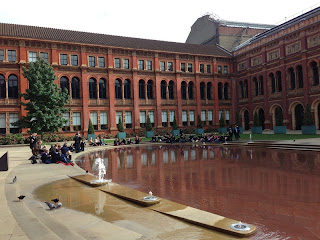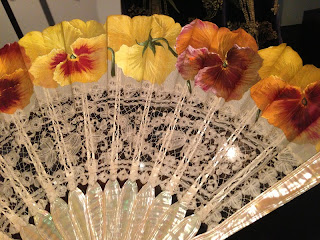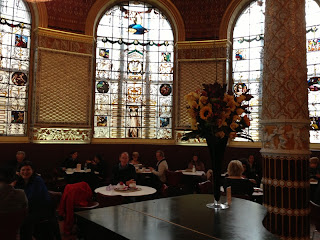After our time in Cornwall and in Dorset and THE BIRTHDAY party we still had a few days before going home. We had so much hoped that we could also have time with James' brother (the 5th sibling) and his wife Jill. Stephen could not come for the weekend since he was on duty but renting a car and driving to see them did not work out either since they had a problem with their house. James was very disappointed and wonders when he will have an opportunity to see his brother again.
So, plan B. Instead of booking a B&B in Nocton he booked a hotel in London. We took the 10am train to Paddington Station via Slough and 30 minutes later we were in London.
The station is right next to Windsor Castle. I missed taking a lovely picture of the castle from the train a few minutes into the ride. I wasn't fast enough.
I love train rides but it didn't take long. James had found (and pre-paid) a hotel very close and we could walk to it from Paddington. Since it was still early the room was not ready yet so we gave our back-packs into storage and headed out.
We headed straight to the Victoria & Albert Museum. It's so easy going around London with the tube (underground) especially if you know your way around like James.
The V&A is free. It has an entry directly from the Metro station. We entered and immediately were in the sculpture section with many Rodin pieces. We didn't know what we actually wanted to see so we decided to have a coffee in the cafe first. That place alone was worth seeing (and the coffee was not bad either). It was rather full so a man approached and asked whether he and his wife could sit with us which was fine with us. He told us that they were from Wales, from the town with the longest name. James says: "Oh, from Llanfairpwllgwyngyllgogerychwyrndrobwllllantysiliogogogoch?" Was that gentleman ever surprised. It was fun! Click here if you want to know more about it and how to pronounce it.
After our "elevenses" we started our tour. First we had to cross the courtyard though. Very nice relaxing place. I so enjoy seeing the school children in their uniforms. I wished our children here in the USA had school uniforms too.
The first exhibition we saw was about the Islamic world. Ladies' dresses. A lady in the white one would have been covered up literally from head to toe. She would wear this over her "indoor cloths". The skirt would be stuffed into the pans which have the "shoes" attached to it.

The Ardabil Carpet
made about 1539-1540 in Iran. The above link to the V&A collections gives more info and photos. This carpet is remarkable and very important ... besides very expensive. To preserve it properly it is in a huge glass case. To protect it from fading, the light comes on only every half hour for a few minutes.
Since we wanted to wait for that, we sat on a bench in front of it where we found a book with more details. The carpet actually had a twin. Both carpets were damaged in an earthquake and sold. The second carpet was used to restore this one ... a great restoration job if you ask me.

Church Vestment from Iran
1600-50
Silk warp and weft with fine silk pile.
Armenian priests wore this, the shurjar, to celebrate Mass.
Screens
Carved and pierced sandstone and marble
Agra
19th century, copied from late 16th century models.
This was very interesting since we had seen these in India ... and had admired them then.

Floorspread, cotton embroidered with silk for the Mughal court and/or export.
Late 17th - early 18th century
 Close-up.
Close-up.So beautiful!

Another exhibition showed FASHION.
The red dress was by Monsieur Vignon and made 1869-70. It had three parts: bodice, skirt and peplum (I had to google on "peplum" and HERE is what else I found ... it is something you can attach to a skirt).

A collar ... raised needle lace
designed by Josef Storck (1830-1902) and made by J. Stamnitzer about 1880.
Fan
Painted by Ronot-Tutin 1890-1900
Painted silk gauze and bobbin lace leaf, with mother-of-pearl sticks and guards.
Brussels needle and bobbin lace

Pelerine (collar) 1830-35
Embroidered cotton
Probably Ayrshire, Scotland

This is a Christian Dior Necklace!
1999
Silver-plated metal, silver-plated lace and glass
Wow! Silver-plated lace!
close-up
I could have taken hundreds of photos but here is just one more which was so interesting ... knitted bathing suits. Oh yes ... James and another lady looking at these at the same time started remembering how it was wearing something like it ... and how it felt coming out of the water. Ha-ha!
Crossing the court yard again ... loved that sign!
Seven rules - rule two: paddling is permitted, but please keep your clothes on.
Lunch time!
Leek and potato soup, bread and butter. May I have the heel please.
The lunch place is just awesome.
Awesome! But where was the piano player?
When we crossed the sculpture place again, I said to James "there is Laura Buhlig". Wonder whether she would agree with me?
Is she related to Lady Belhaven and Stenton?
This marble bust was signed and dated by Samuel Joseph (1791-1850) in 1827.
More info here.
And found more info here.

This was just awesome: The Stoning of Saint Stephen (1680-1710) by Grinling Gibbons. We stood there quite a while looking and looking ... but I could not take a good picture to show you but here is a link!
We had already seen some of his work in Hampton Court and here is some more info about Grinling Gibbons.

Another piece which fascinated us: Embroidery from Stoke Edith, Herefordshire (1710-1720)
And the things you find when you google. Here is an audio review of it and more info by the VAM.
 There was so much to see, study, read in this museum that you can easily miss something. James found the following information on the sign next to it which I too found very interesting: Accepted by HM Government in lieu of Inheritance Tax and allocated to the Victoria and Albert Museum.
There was so much to see, study, read in this museum that you can easily miss something. James found the following information on the sign next to it which I too found very interesting: Accepted by HM Government in lieu of Inheritance Tax and allocated to the Victoria and Albert Museum. How about that?

This is the wedding suit worn by King James II in 1673
More info here!

Here is a woman's smock (1620-1640), smililar to a man's shirt. All linen including the bobbin lace.
 Insertions and edgings are all similar patterns but with different size threads, some finer then others.
Insertions and edgings are all similar patterns but with different size threads, some finer then others. 
A Man's (bobbin) Lace collar
1630-1640
1650-1680
The bright red thread was probably dyed with cochineal (South American insect) which was new to Britain in the 17th century. The softer purplish red could be achieved by using the English dye, madder.
Italian (needle) Lace Border
1600-1620
punto in aria = stitches in the air
Lace Border
1620-1640
This pattern features characteristic Jacobean motifs, such as the English Tudor rose and the Scottish Stuart thistle.
I have not seen a pattern like this before!

A Detector Lock from about 1680 made by John Wilkes.
In the museum there was a screen next to it showing this video explaining how it works. I was so happy when I found it because the lock is amazing.
There came the moment of sensory overload again. There were many things which didn't photograph well like the Triple Portrait of Charles I. I really liked it. So many interesting things, paintings, furniture, and even whole rooms transferred from an estate including the wall paper and ceiling ornaments.We took the tube back to the hotel. Our room was ready and we rested for a while. And yes, free internet, ha-ha!
And then we headed out again. James had booked tickets to see a musical in the Phoenix Theater "Blood brothers".
We took the tube to a station close to the theatre and found a pub. We were determined to eat English food whenever possible.
James had "Beef and Stout pudding".
Standing ovation. Of course you can't take any other pictures.
What a lovely day altogether!!!





























No comments:
Post a Comment